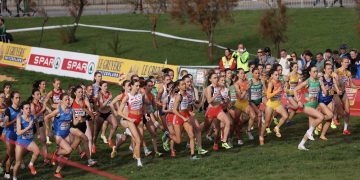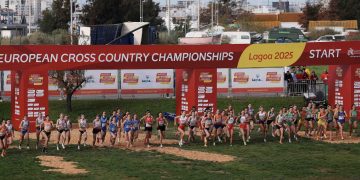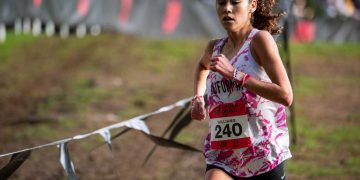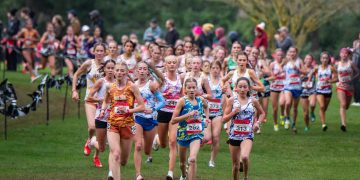Brooks Johnson has been, and is a contrarian. While I have disagreed with Brooks on many occasions, he has always responded with candor. This dates back to
our first meeting over thirty years ago.
I first met Brooks in 1977 at a coaching clinic in Northern California. I accosted him outside a clinic and challenged him on his comments on American distance runners not being able to race at the end of races. I found his resolution of that issue to be contrary to my beliefs. He challenged me to think outside of my normal process. From that, I learnt a huge life lesson. It was not the last time that I disagreed with Brooks.
In the early nineties, when my family was literally making it on pennies due to our starting American Track & Field, Brooks came up to me, and very quietly asked if he could help us financially, he knew we were having trouble. My two jobs were assistant coach at Foothill community college and managing an apartment complex in Mountain View, CA. Brooks’ offer came out of the blue. It was thoughtful and surprising, as I did not know him well. I was taken aback. I thanked him and declined. But the offer was there, and it still affects how I feel about the man. He did not have to make the offer, and he would continue to provide me with his thoughts and comments on our sport. At the time, he was especially incensed about the lack of marketing behind women’s track & field.
I coached a group of athletes after their college days with Brooks and their feelings were mixed. Some still worship him, and some had issues. What else would one expect with any coach at a high powered program like Stanford in an era of upheaval in our sport and our perception of the sport.
One more story. At the old adidas Oregon meet, I believe in 2005, I had dinner with John Smith, Brooks and Said Auoita. The topic that night was the history of the 400 meters and also training the classic middle distance runner. To this day, I wish I had a tape recorder. I learnt more in that 90 minutes, sitting and listening to John, Brooks and Said speak on coaching and training than I had in many a night.
The following is Brooks’ response to the relay controversy among others. You will find his comments on some other areas at http://blog.spikesandflats.com/
Look at some of the athletes he coaches: David Oliver and Tiffany Ross-Williams. Oliver took the bronze in Beijing. His mastery of the event and his self confidence in Beijing were extraordinary. Tiffany Ross-Williams needs to
Brooks Johnson is a study in contrasts. He is a combination of the urbane and profane. He can write, and the soul searching is obvious. You can speak with him, and depending on his trust of you, and your previous interactions, you may find a him very communicative or frustratingly obtuse. In the end, his observations, his athletic experience, and his coaching, like many elite coaches, has been tremendous boons for the right athlete. More than anyone in coaching today, Brooks Johnson proves that coaching is both science and art, and salesmanship.
FROM EUGENE TO BEIJING
The Olympic Trials in Eugene, Oregon were an unequalled success. Everything possible was done to assure the most competitive and successful Trials of all time. The Trials results bore ample witness to this fact. The Trials ended on Sunday, July 7 and entries to the USOC were due on Monday, July 8. The Chinese had arranged for the Games to start on 08-08-08 ( 8 is a lucky number for Chinese ), or August 8 of 2008. Track and Field started on August 15 ,a week later. That gave American athletes approximately six weeks recovery between the time they made the team and the start of track and field events in Beijing. The time in between, and how it was used, was naturally a huge challenge.
Some athletes, departed for Europe immediately after the Trials to cash in on their Olympic Trials success. In the case of the sprint relay ( 4 x 100 ) candidates, they were required to be in Stockholm, Sweden on the 19th of July for a series of relay competitions and training. The first event was the 22 of July in Stockholm, then the 25th of July in London, and the 29th in Monaco. Each training session and competition was filmed using the DARTFISH video system and we employed two DARTFISH cameras. One of the cameras was manned by a PHD in bio-mechanics, Dr. Iain Hunter. There were extensive drills that preceded each training session, including stationary drills that emphasized proper hand presentation and grasping of the baton once it was inserted into into the hand. Imagine the surprise when this was the aspect of the passing exercise that failed us in Beijing after we had worked so long, often and hard at this precise execution technique.
What we found when we collected all the candidates in Stockholm was a wide range of degree of recovery from the Trials. There were some athletes who had remained at home, rested and recovered from the Trails and as a result were fresh and ready to go. On the other hand, there were some who had come directly from the Trials to Europe and were just about totally expended and on their very last legs, a mere three plus weeks before they were to start the Games. One athlete advised me, ” Brooks I just want to go home ! I came over here right after the Trials and I haven’t run or felt well the whole time I have been here. I can not go on to London and Monaco. Can I meet you guys in China after Stockholm ?”. This athlete was excused and went home and came within a week or so of making a full recovery by the time the Games started. Another athlete made two trips to and from Europe after the Trials until we met in Stockholm on the 19th. This athlete was still able to get almost all the way back by the Games, winning a silver and gold medal.
The head coaches of the U.S. team, based upon input from scientists and empirical experience from the previous year’s World Championships in Osaka, Japan, decreed that athletes needed to be in the Beijing time zone at least 10 days before the start of their event. Athletes were required to check in with the Olympic staff in the Village five days before the start of their event. There was a training camp set up in Dalian, China where athletes could come and train prior to going to Beijing. They were allowed 10 days at no cost to themselves. Provisions were made for their support and medical teams to be housed there as well. We were housed in a deluxe resort hotel, with an American chef, and police escort to and from training sessions twice a day. The training facilities were “A” level and the Chinese support staff could not do enough to make our experience there a rewarding one.
Despite the fact that our water had been tested and cleared by American technicians, and even with our having our own American chef at the training camp, there was still more cases of stomach issues than usual. I was working with David Oliver and Tiffany-Ross Williams, both of whom had to miss work days at the training camp because of stomach issues and diarrhea. During the rounds of the 110 hurdles at the Games, Oliver suddenly bent over in obvious discomfort on his way to the Call Room just prior to his race. I held my breath that he would be able to finish his race and advance and not “lose it ” in the process. These two certainly were not isolated cases and to some degree just about everyone on the team and staff had some sort of stomach episodes. I can remember talking with Bubba Thornton, the men’s head coach, about this issue.. He once stated, ” Brooks, when I go to a new place, the first thing I do is to find out where the nearest toilet is.”. I laughed because we shared the same survival strategy.
On just about every level possible, China in general, and Beijing in particular, was a study in contrasts and surprises. We had been prepared by the media and USOC scientific studies to expect polluted air. The air never presented a problem. Polluting factories were shut down and automobile traffic was halved each day by alternating by license plate numbers who could drive on each day. As a boy and young man, I had often read stories about the Chinese not having enough food to feed themselves. Once in China, I was surprised to see a very robust restaurant industry with Chinese filling these establishments and themselves on a nightly basis. I had been advised that the Chinese were racists and considered blacks inferior. Yet we blacks were singled out, in some cases embarrassingly so, to pose with them for pictures, and in general given preferential treatment. The traffic, both on foot and streets, was extremely intense and crowded, but in the more than two weeks I spent in China, I do not remember a horn being blown in anger. China is supposedly one of the last remaining communist/socialist countries, but the amount of private enterprise and emphasis on materialism and materialist consumption was truly amazing. The Chinese dislike America, but it is obvious that they like Americans. In order for a student to move from middle school to high school, she/he must pass an English exam, or be assigned to a trade school. In a country we viewed as being desperately poor and backward not that long ago, there was evidence all around of a very robust, well-ordered, and upward spiraling economy and society.. A popular joke among foreigners was, ” What is the national bird of China ? ” The answer, ” The crane,…..the building crane.”.
As stated above, China and Beijing were a source of great contrasts and surprises. I have been on national teams since making the U.S. Pan American team in 1963. I have been on four Olympic staffs and numerous other teams as well. In my personal experience over that more than four decades, we have never had a logistical and management support staff as well trained and knowledgeable as the one we had in Beijing. Sandy Snow was the Team Leader and put together a staff that was both very hard working and carried out their respective tasks with a level of effectiveness and efficiency unseen prior to 2008. I recall the World Championships in 2003 in Paris, France where the food, to everyone’s surprise, was horrible. Yet no one had stomach issues. In Beijing, the food was at an all time high. Yet we had too many people with stomach issues.
Somewhere in all this there is a lesson. Perhaps George Williams, the 2004 men’s Olympic head coach, stated it best, ” You do not know the play unless you are in the huddle.”. There has been a great deal of remote armchair criticism and consternation about the performances of U.S. track and field athletes in Beijing. A great deal of that criticism has been leveled at the Olympic coaching staff. What is being missed is the fact that the same personal coaches and support people that worked with our athletes in Eugene, where we had outstanding performances, were the exact same people, in almost all cases, supporting them in Beijing. Did these personal coaches and support people become cretins in a little over a month ? Hardly ! It is a fact of life that we lose between 3-5 medals between the Olympic Trials and the Olympic Games. That figure is based upon the fact that if our athletes perform as well at the Olympic Games as they do at the Olympic Trials, we would win 3-5 more medals. The High Performance Division of USATF has recognized this and over the past several years has held conferences and seminars with coaches, athletes, scientists, and stake holders to identify the secret to being able to replicate at the Games what we do at the Trials.
As Chair of the High Performance Division, it was my responsibility to see to it that we had the plans,programs and projects in place to ” maintain current medal count and increase the medal count where ever possible in major international competition.” When the HPD came into existence ( 2001 ) the U.S. was down to less than 15 medals with drug busts for 2000. We reached a high water mark in 2005 and 2007 at 25/26. It was always our ultimate and endgame mission and mandate, however, to win the medal count,… which we did in 2008. The planning for 2008 was based upon replicating the successful modalities and models that had worked so well for 2004, 2005, and 2007. It did not produce the same number of medals. That was/is perhaps the greatest surprise and contrast that Beijing had in store for us.
For more thoughts from Brooks, check out http://blog.spikesandflats.com/
For more on our sport, please check out: http://www.american-trackandfield.com
Author
-

Larry Eder has had a 52-year involvement in the sport of athletics. Larry has experienced the sport as an athlete, coach, magazine publisher, and now, journalist and blogger. His first article, on Don Bowden, America's first sub-4 minute miler, was published in RW in 1983. Larry has published several magazines on athletics, from American Athletics to the U.S. version of Spikes magazine. He currently manages the content and marketing development of the RunningNetwork, The Shoe Addicts, and RunBlogRun. Of RunBlogRun, his daily pilgrimage with the sport, Larry says: "I have to admit, I love traveling to far away meets, writing about the sport I love, and the athletes I respect, for my readers at runblogrun.com, the most of anything I have ever done, except, maybe running itself." Also does some updates for BBC Sports at key events, which he truly enjoys.
Theme song: Greg Allman, " I'm no Angel."
View all posts





















